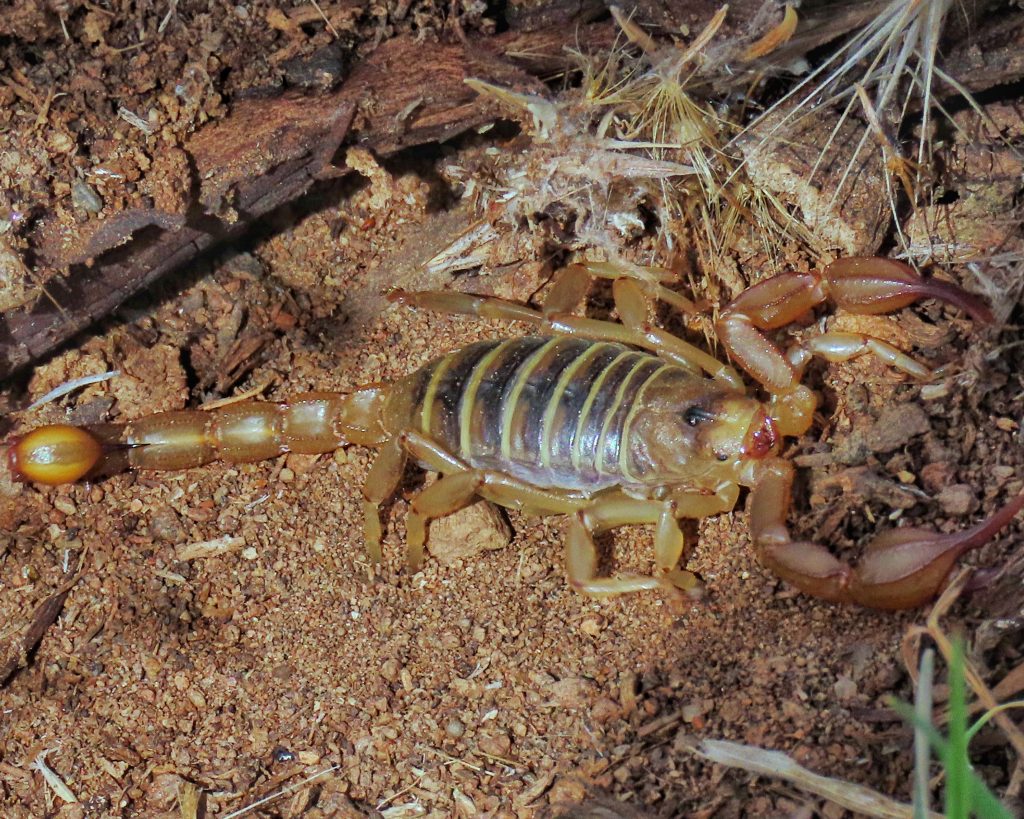
For my 300th species profile I decided to go with something that I last found last spring. The reason I went with this ‘blast from the past’ was that I realized that by doing so I would contribute the 150th family, and 60th order, to this survey of the lifeforms of the PNW. I set out to document the amazing diversity of our region, and thus far I seem to be making progress. There are, at present, only 5 species of scorpions known from our region. Paruroctonus boreus is the most commonly found, but Uroctonus mordax (Western Forest Scorpion) is not uncommon, at least in Oregon. However its range only extends into the southernmost portions of Washington state, and north of that the only scorpion recorded is the Northern Scorpion, although the arachnologist Kari McWest suspects we may have others, since the region is under surveyed for scorpions. Paruroctonus boreus is the only species of scorpion found anywhere in Canada, reaching up into BC and Alberta.
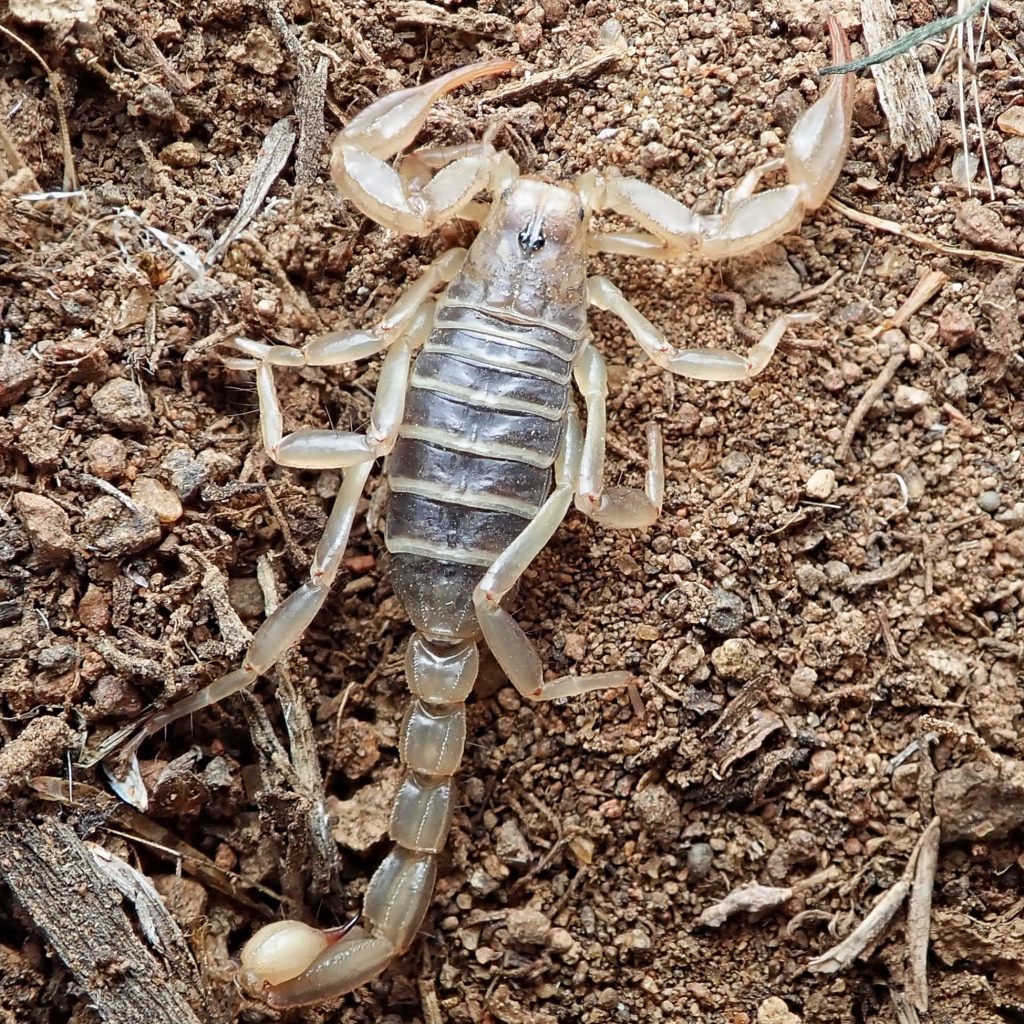
And scorpions are just really cool! Most of them, including Paruroctonus boreus, don’t deserve the level of fear they engender. Its sting is not pleasant, but it is not medically significant. In fact there are so few problems associated with the sting of a Northern Scorpion that the medical community hasn’t even bothered to analyze their venom. It is said that the sting is not as painful as that of a yellowjacket but, despite handling several of them over the years, I’ve never been stung and so can’t attest to that. In my experience they are not aggressive and will try to get away from any threat, and when I’ve let them crawl over my hand they have never shown a desire to sting, although that is not to say they wouldn’t, and ‘playing’ with scorpions is certainly not something I would advise.
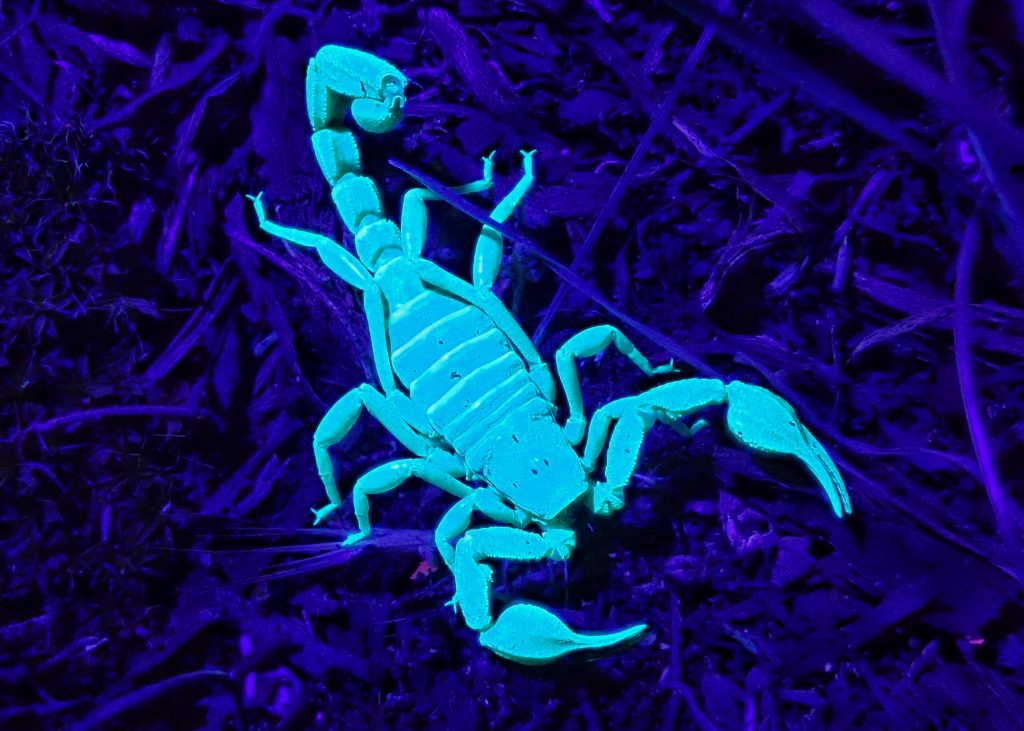
Scorpions are UV reactive due to chemicals contained in the cuticle of their exoskeleton, which means they will fluoresce in the beam of a flashlight illuminating in those frequencies. In other words they can be made to glow in the dark! This is not only very cool, but it is an important tool for scientists studying these nocturnal creatures who spend all of their daylight lives in burrows or under cover. And I doubt that either I or my nbo Morgan will ever forget the sight, during a rockhounding trip to se Oregon, of the first Northern Scorpion they located in the beam of a UV flashlight. It was nearly magical to see it glowing and so perfectly delineated in that little circle of dark blue light. Nobody really knows why scorpions are UV reactive. It could be that they can utilize it to find mates, or that it confuses prey or predators, or that it acts as sunblock. Given how photophobic scorpions are (probably due to risk of desiccation) I think the most likely explanation is that they are receptors which let the arachnid know when it’s dark enough to go prowling.
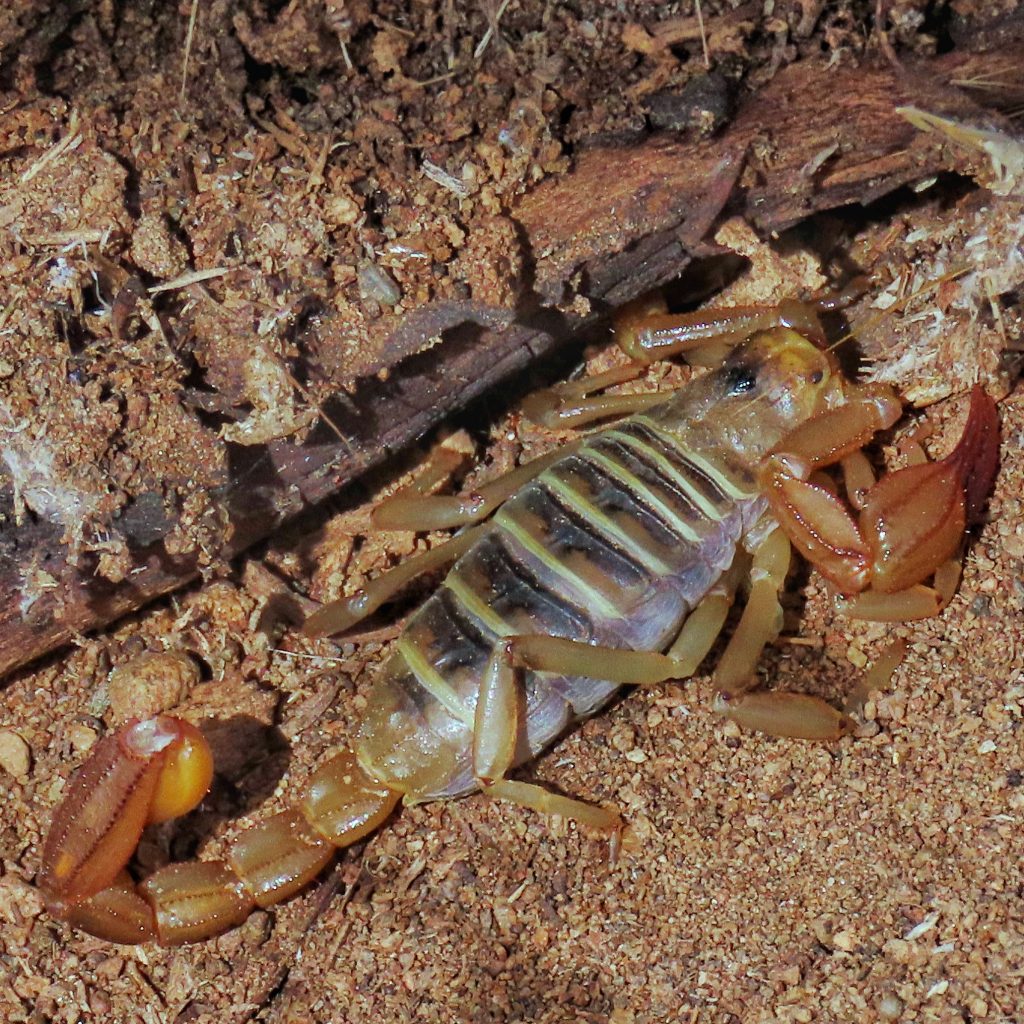
Scorpion courtship is highly ritualized, and stylized enough to earn the appellation ‘promenade a deux’. It is very similar across all taxa of scorpions, which attests to its efficacy. It is assumed that the singularity of pheromone composition for each species precludes the need for differentiation via the courtship ritual. The mating process starts after the male locates a suitable female. He then begins ‘juddering’, a quick, pulsating, shivering movement that sends vibrations through the ground, and if the female is receptive she will allow him to approach. At this point there may be ‘clubbing’, which means striking each other with the tail without stinging. The male then grasps the pedipalps (pincers) of his prospective mate, and they move close for a mutual cheliceral massage (which is not a euphemism for a kiss, although it probably functions as one) and then he guides her through the complex steps of the promenade a deux, which, for Paruroctonus boreus, may include headstands by the female! This dance can last anywhere from a few minutes to a few hours. When the male senses the time is right he engages in sand scraping, after which he deposits an elongated spermatophore (bag’o’sperm) on the scraped area, and cements it in place. He then pulls the female over the spermatophore, which she pulls into her body. At this point male Northern Scorpions disengage and flee the scene, since post coital cannibalism is not rare, while the female sways back and forth for awhile.
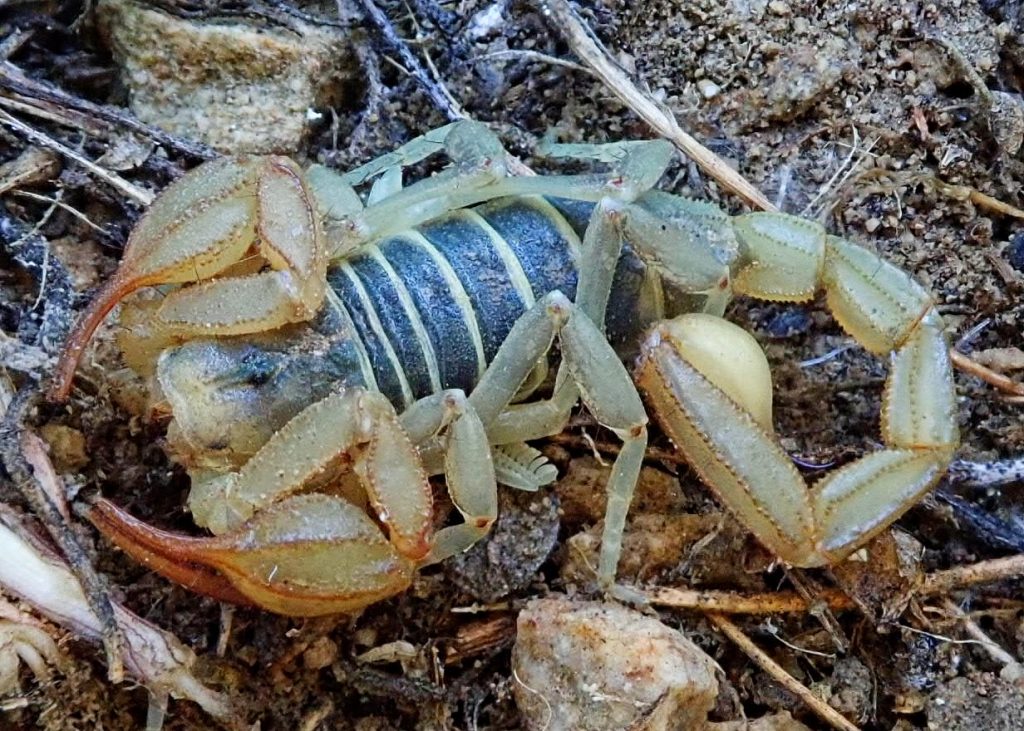
Paruroctonus boreus, like all other scorpions, is viviparous, meaning they give birth to live young. Fertilization may not be immediate, and gestation can take up to 8 months. Usually in late July/early August they give birth to around 20-25 young. Once the young have fought through the membrane they are birthed in, they climb upon their mother’s back, and remain with her until their first moult in 7-10 days. After that they venture off to make their way in the world. Viviparity, especially in conjunction with some level of parental care, conveys survival benefits to individuals in the litter, but there is the trade off of significantly decreased numbers of eggs produced, and increased vulnerability of the maternal individual. But obviously it is working for them, since scorpions first appear in the terrestrial fossil record 400 million years ago.
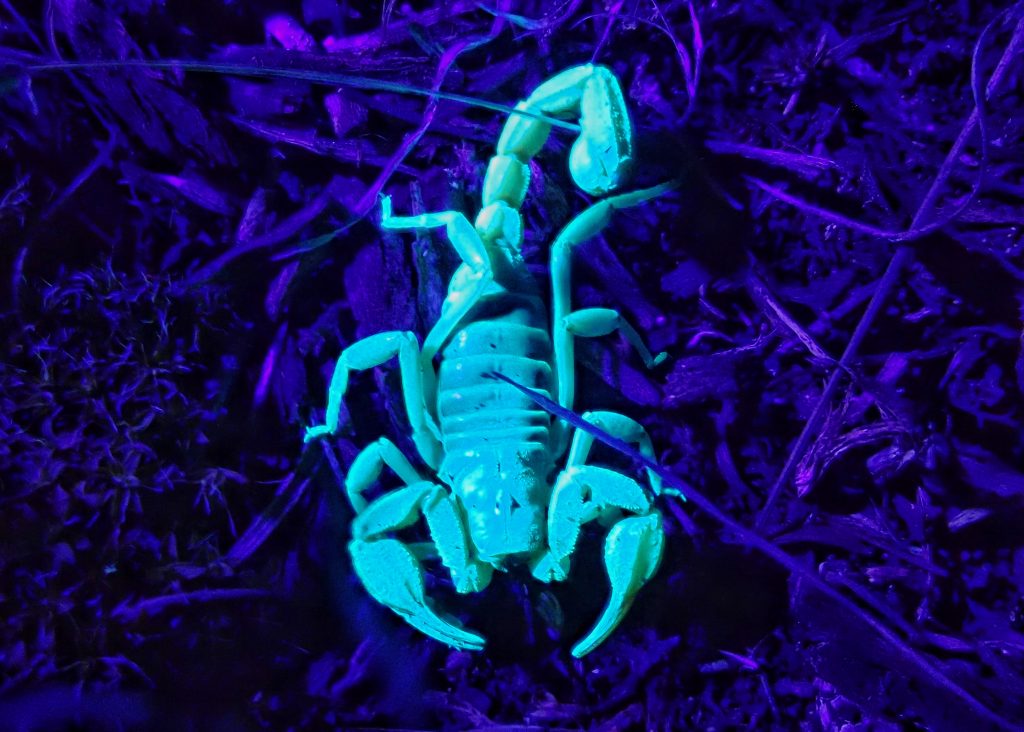
Northern Scorpions are ambush hunters. Their vision is poor (their eyes don’t distinguish much more than light and dark) so they rely on prey coming within reach of their pincers. They don’t bother to sting their prey if they can subdue it with their pincers and chelicerae. Activity begins about a half hour after sunset, and the first hour and a half of the evening contains the most activity. They don’t seem to be active at temperatures under 50⁰, and become more active the warmer the night. Except that in prolonged periods of zero precipitation they tend to become less active the warmer it gets, possibly because of the risk of desiccation. Males may travel up to 100’ per night, probably searching for mating opportunities, since females seldom travel more than 15’. Northern Scorpions don’t need to feed every day (captive females only ate 1-2 small crickets per month), so that, outside of mating periods, they often don’t leave their burrow or covered area for extended periods of time, even during the summer.

I’m only hitting the highlights here folks! These are fascinating creatures and I highly recommend that anyone whose interest is piqued by this profile explore the more detailed information on them that is contained in the links below.
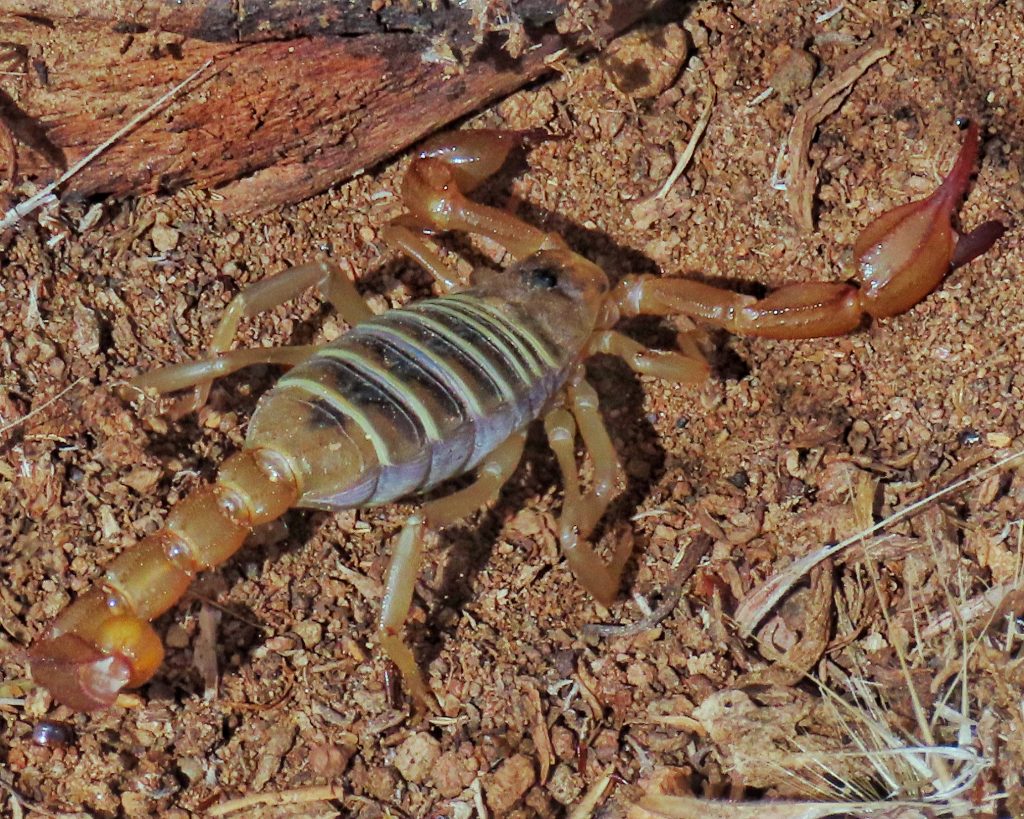
Description-Medium sized (up to 2”) scorpion, usually has a brown body with a light colored line at the hind edge of each segment, with yellowish light brown tail (metasoma), legs, and pincers (which are actually modified pedipalps, and are not legs); the telson (stinger) is light yellow and noticeably more swollen than the other segments of the metasoma (tail); there is a pair of median eyes on a raised area in the middle of the carapace, and a cluster of 3 lateral eyes (the smallest of which is at the rear) along each side of the carapace near the front corner; the triangle formed by median and lateral eyes is also pale yellowish brown; whole scorpion may be darker in areas with a dark substrate; front of carapace has slight outward bulge.
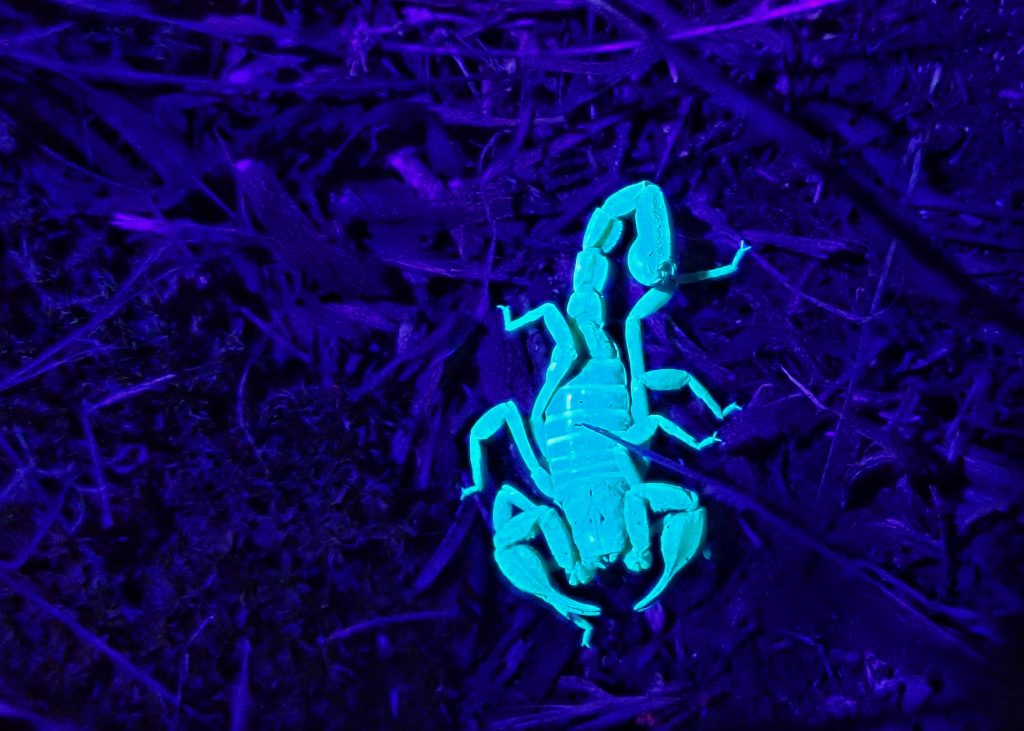
Similar species–P. silvestrii doesn’t have a pale line across each abdominal segment; Paravaejovis confusus is more uniformly yellow; Uroctonus mordax has the front of the carapace indented, has a carina ending in a ‘y’ on the underside of the 5th segment of the metasoma (tail), tends to be much darker, and is usually found in or near forested areas; other scorpions (mostly s Oregon/n California) are larger or have an indented front of the carapace.
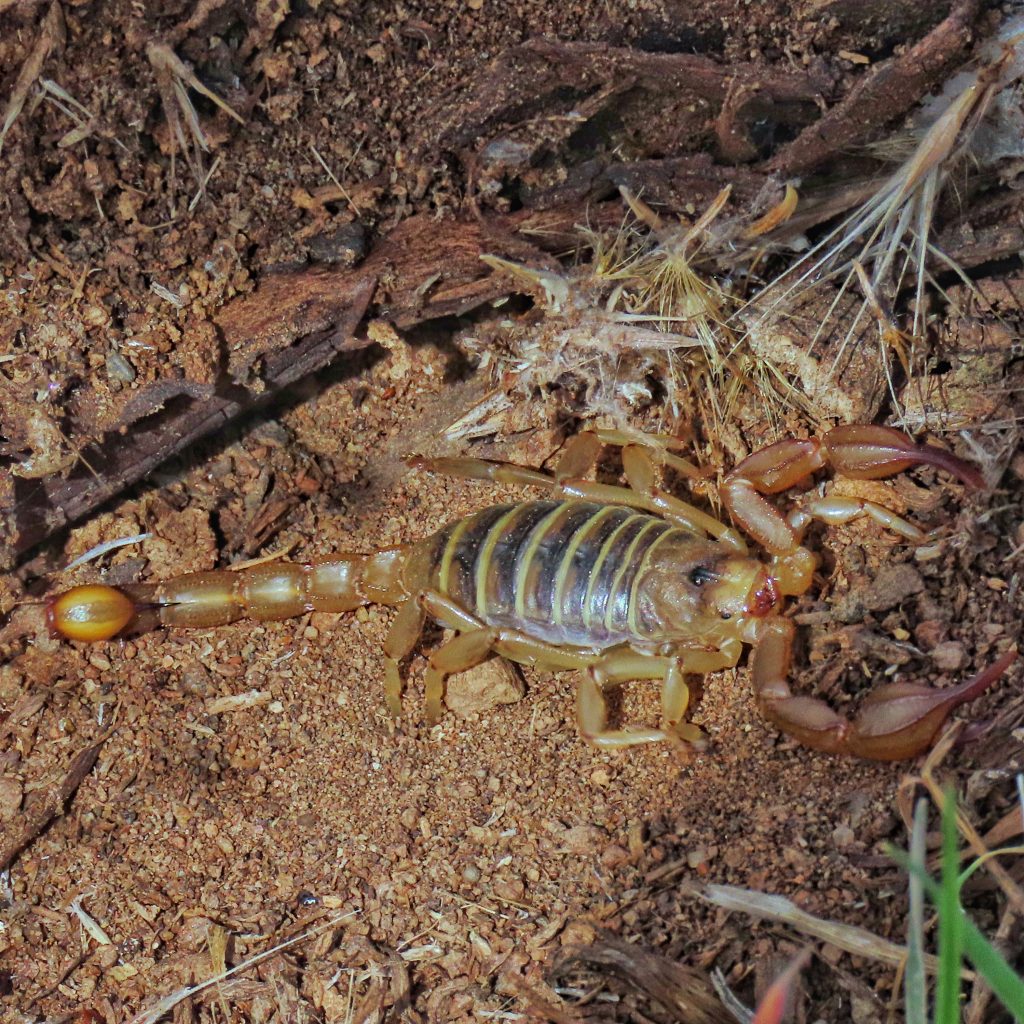
Habitat– Open, arid, rocky or sandy areas in sagebrush and shrub steppe; only found in areas with 10-20” of yearly precipitation, and tends to be at progressively lower elevations the farther north you go; relatively absent in grass dominated areas.
Range-Western North America; from east of the Cascades to the foothills of the Rockies in our region.
Eats-Young ones (1st, 2nd, 3rd instar) tend to choose soft bodied prey like grubs and termites; older immatures and adults feed on spiders, grasshoppers, crickets, beetles, and stinkbugs.
Eaten by-Owls and other birds, snakes, insectivorous mammals, and Jerusalem Crickets (Stenopelmatus spp.); cannibalism has been reported, although primarily in captivity.

Reproduction-Females give live birth to up to 45 young (avg. 24) in July/August
Adults active-April to October in our region, with possible forays on warm nights during the months in between.
Etymology of names-The only resource I could find that purported to give the etymology of Paruroctonus claimed it was a combination of Greek and Latin words and meant ‘adorned comb’. That didn’t make sense because they usually don’t combine Latin and Greek words. I tried breaking it down myself and ended up with Greek words meaning ‘beside tail killer’, which led me to wonder if there was a Uroctonus scorpion genus, and there is. So I’m fairly certain that Paruroctonus means ‘similar to Uroctonus’ with Uroctonus meaning ‘kills with its tail’, a fairly obvious reference to the venom filled stinger (telson). The specific epithet boreus is from the Greek for ‘northern’, and refers to the fact that this species range extends farther north than any other scorpion in North America.
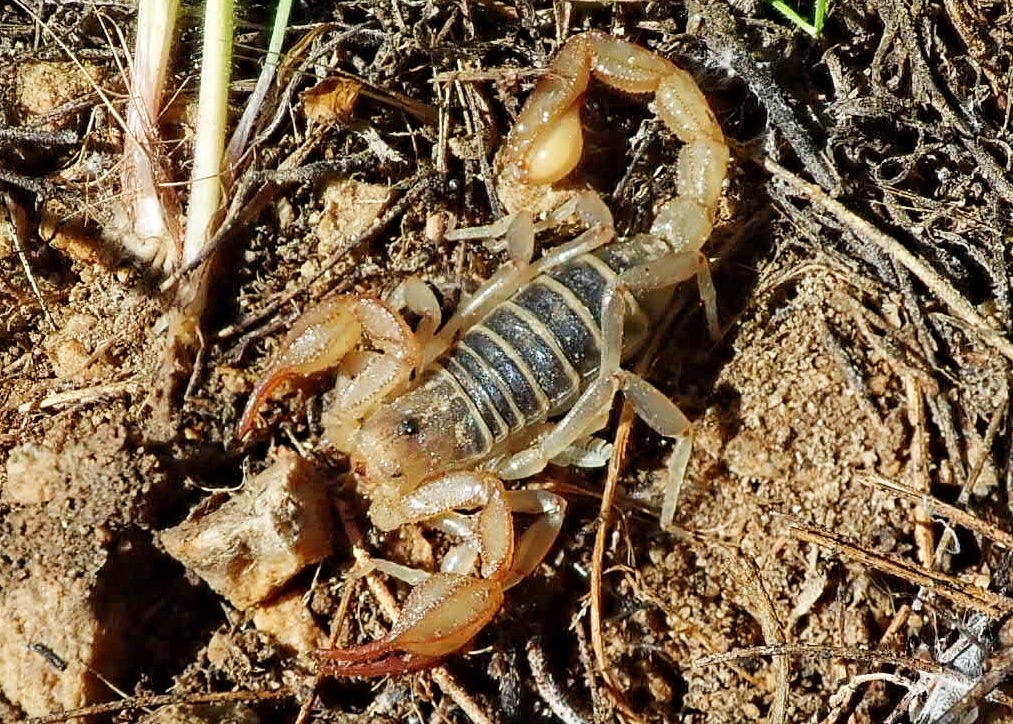
https://scholarsarchive.byu.edu/cgi/viewcontent.cgi?article=1896&context=gbn
https://bugguide.net/node/view/163797
https://arc.lib.montana.edu/ojs/index.php/IJS/article/download/1109/884
https://www.jstor.org/stable/41717788?seq=1#metadata_info_tab_contents
https://www.insectidentification.org/insect-description.php?identification=Northern-Scorpion
http://fieldguide.mt.gov/speciesDetail.aspx?elcode=ilara64020
https://wiki.bugwood.org/HPIPM:Colorado_Scorpions
https://scholarsarchive.byu.edu/cgi/viewcontent.cgi?article=2393&context=gbn
https://www.tmparksfoundation.org/animals/northern-scorpion
https://digitallibrary.amnh.org/bitstream/handle/2246/3294/N2278.pdf?sequence=1
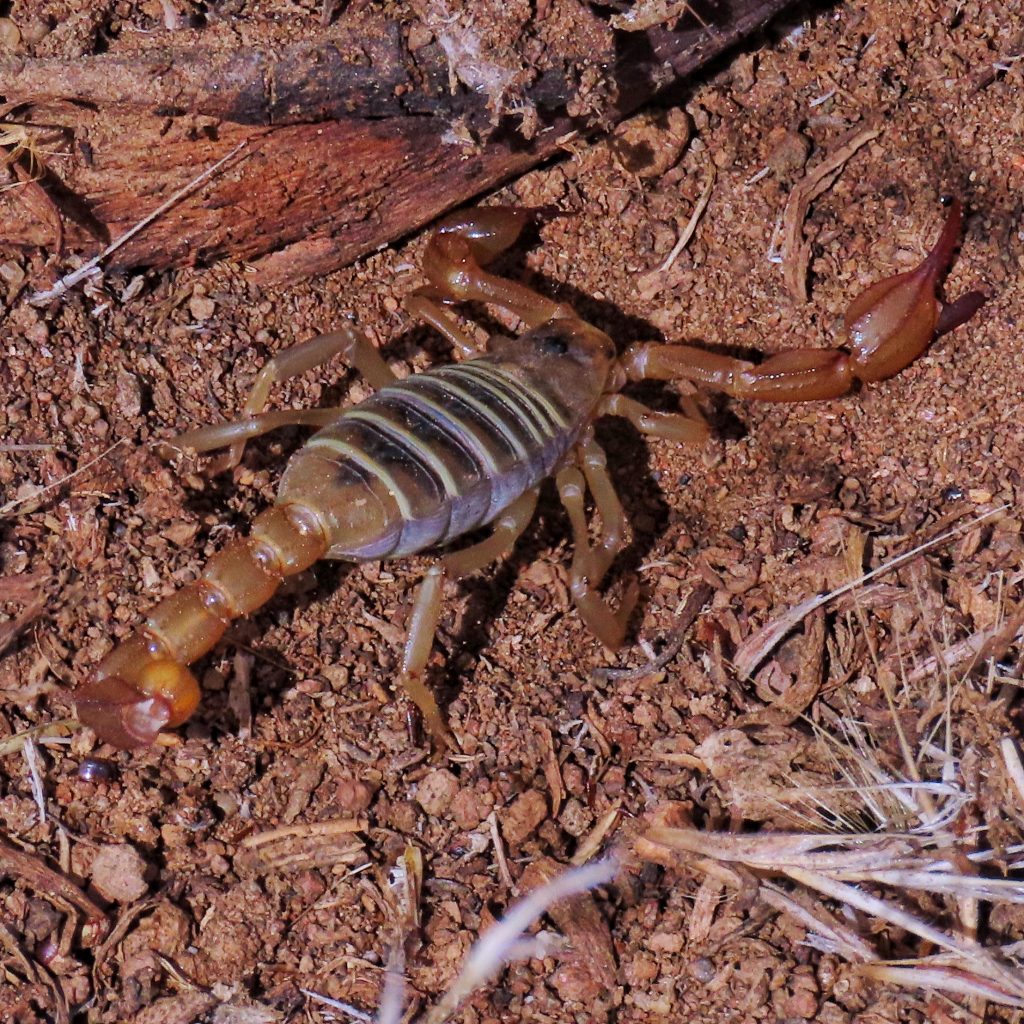
Oh wow this entry is wonderful to read! So many of us don’t realize we have scorpions here.
I was in the Peace Corps in Malaysia in 1970, and lived in a kampong (small village) in a wooden house. Bugs were everywhere, and one day I opened a window. All along the lower casement was a mass of tiny scorpions. They were vey light-colored, practically transparent. A vivid memory!
Sounds very cool! I’d love to see that. Thanks for sharing that with me.
Great site thx for info, I caught over 60 of these scorpions this year when normally have only encountered 2 or 3 a year, not sure why this year was so crazy but I’ve learned a lot about them and learned more on the other bugs here you have identified . Thank you.
Thanks! Where did you find them? I used to find a ton of them at Lava Beds National Monument, but since then it’s just 1 here or there.
This sounds like the scorpions that invested the tribal hatchery in Bridgeport, Washington back when it was brand new (~1990). I was totally freaked out because I never realized scorpions existed this far north. There are a couple things that are not consistent with the behavior you described. Hundreds of scorpions remained active all day long, constantly moving around the floor (a pulsating carpet). I eventually realized that they were doing nothing to me other than walking over me to get somewhere. I recall there were larger blackish scorpions that my colleagues said were feeding on these smaller scorpions. My memory may be wrong, but it seemed that the scorpions were more like an inch, skinnier, and mostly yellowish or even orangish. Does that make sense or do you think I was witnessing another scorpion species? Juvenile northern scorpions? Also, what might the larger scorpions be? Too bad I never took a photo or video of this.
That is bizarre, Olaf! According to the books, they would have to be Northern Scorpions, probably young ones and old ones, but really I have no idea! How long did that last? Thanks for telling me about it!
I think this scorpion mass behavior continued for at least a few months. I moved my work station to the tribal headquarters, then quit my job and moved to Vancouver within the year, and never returned. The hatchery was built between the basalt cliffs/caves and the Columbia River, so it was a highway for other critters, especially snakes. I remember looking out the window at dozens of large rattle snakes weaving their way through the folding chairs and hoping they would all clear out before the dignitaries showed up for the grand opening of the hatchery at noon.
Was this opening by chance in the fall or early winter? Maybe they were looking for a place to hibernate? Wish I could find out more about this strange phenomenon!
I think it was August or earlier.